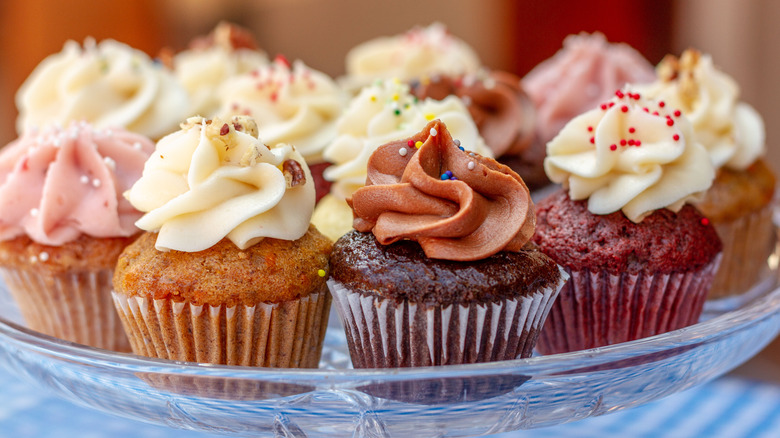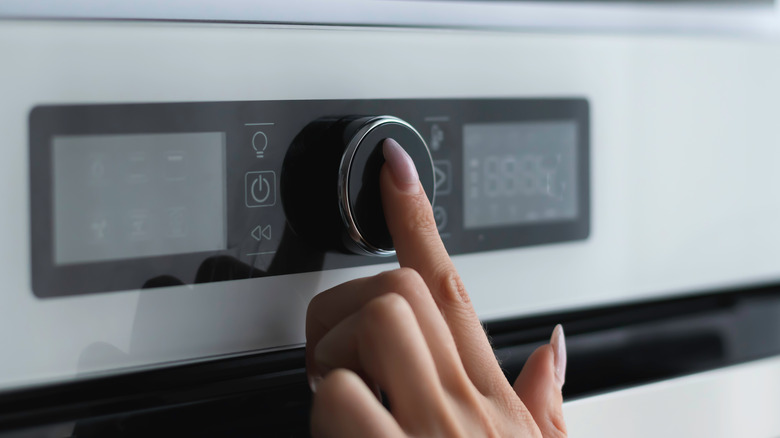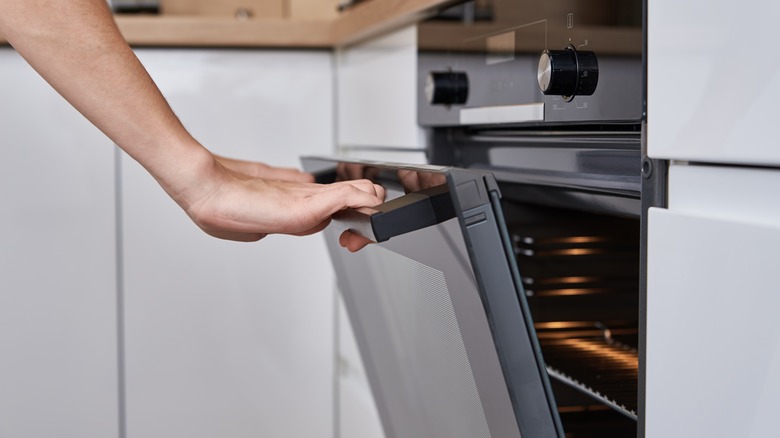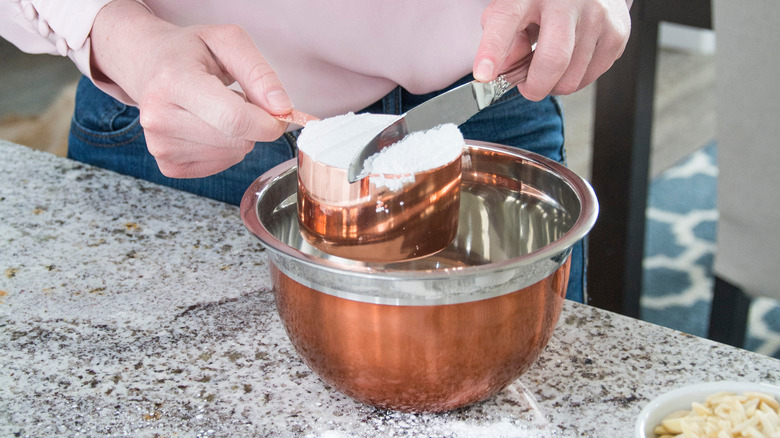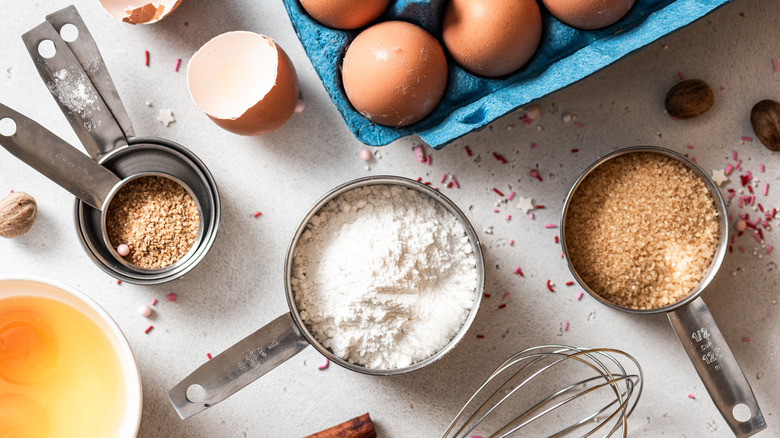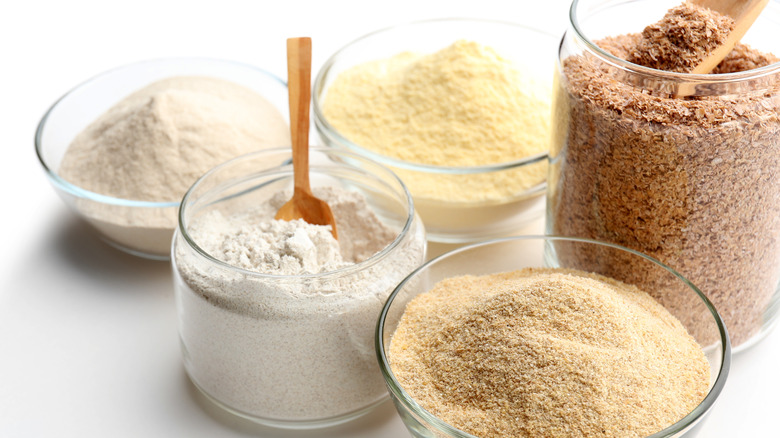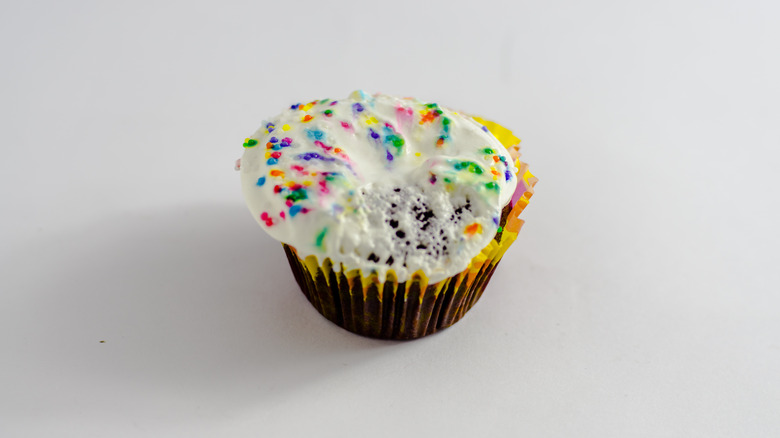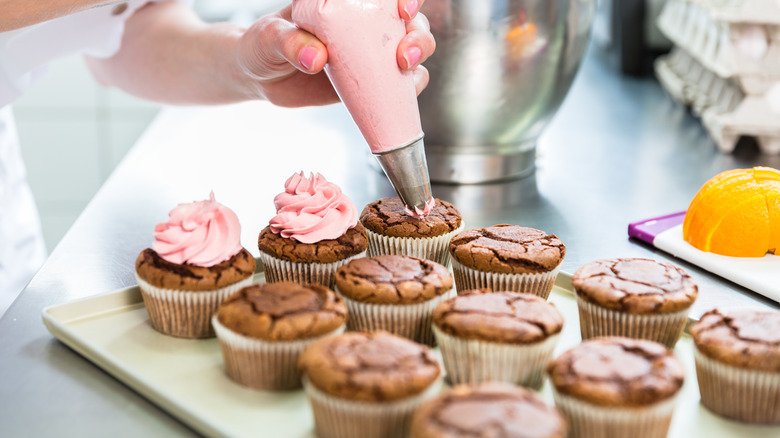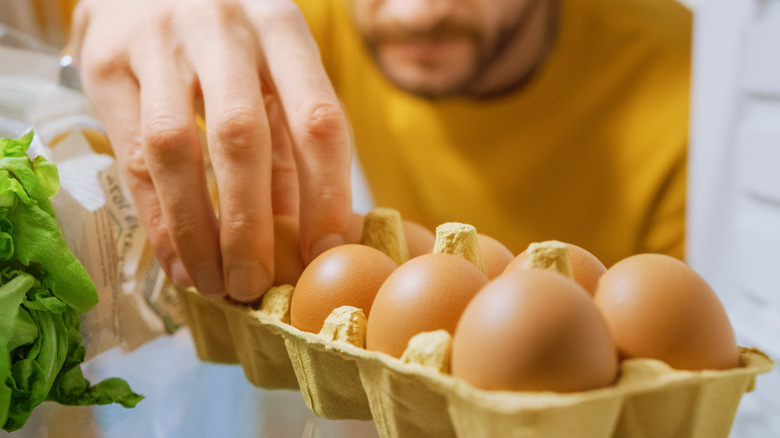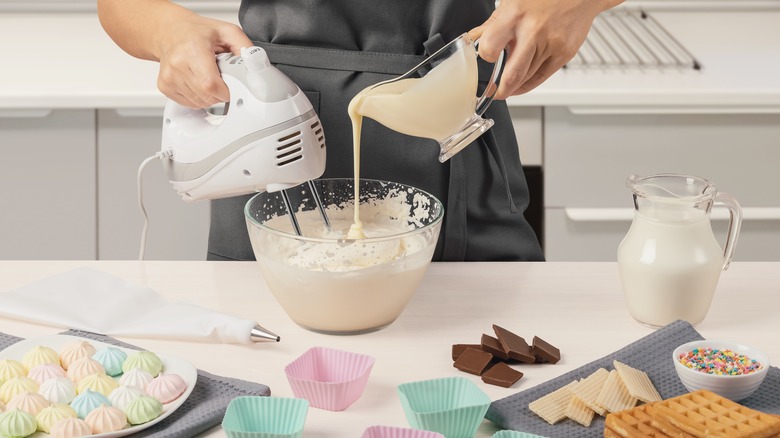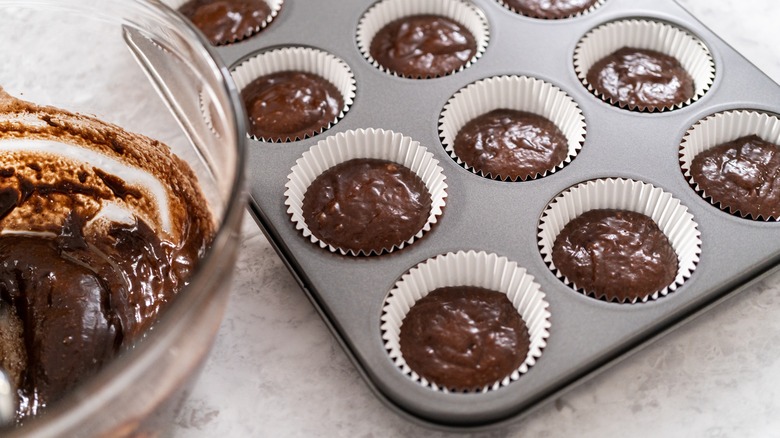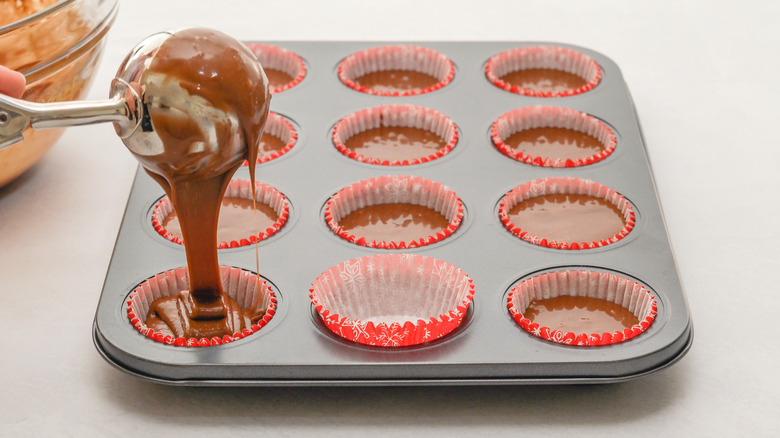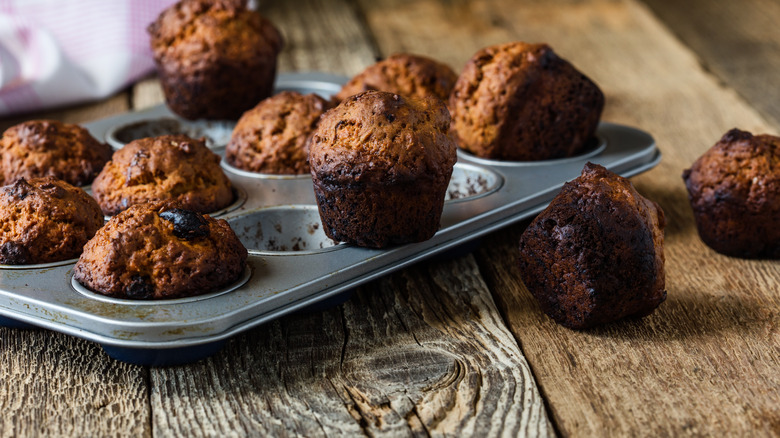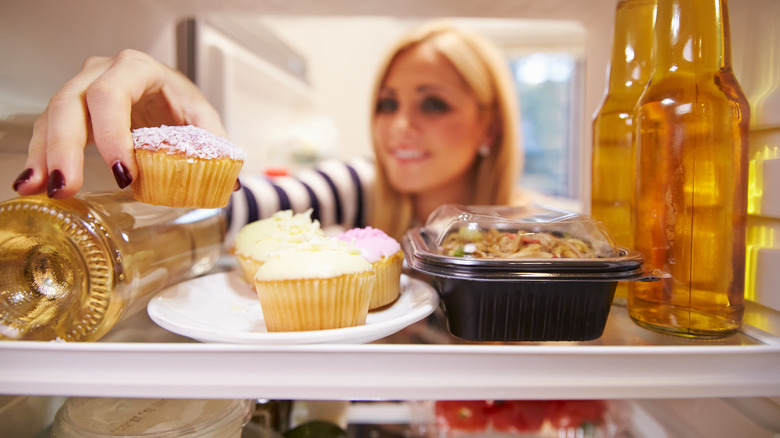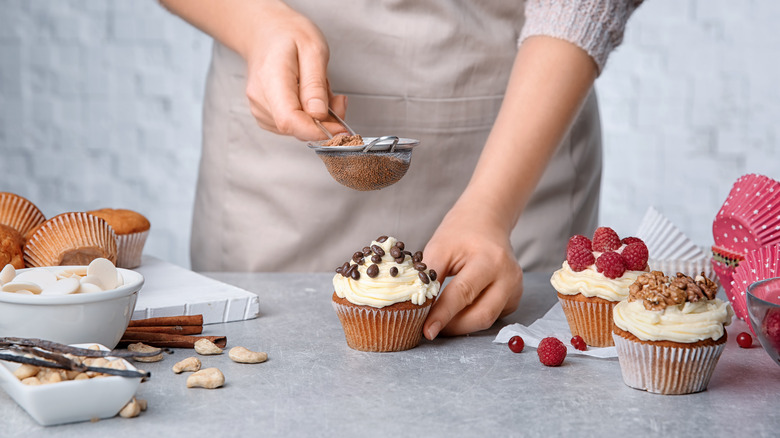Mistakes You Need To Avoid When Making Cupcakes
What's not to love about a cupcake? They're perfect single-serving cakes, fun to decorate, adorable to look at, and easy to make. Well, maybe easy isn't the word. Since cupcakes are basically just cute, bite-sized versions of real cakes, we often think of them as simpler to bake and less difficult to mess up. Unfortunately, when it comes to baking, there's a ton of room for error — even if you're using a three-ingredient boxed mix.
If you've ever watched a baking show, you've likely heard that baking is a science. Like chemistry, baking involves using exact measurements, mixing ingredients with different properties, and using extreme temperatures to change states of matter. You might not look at a chocolate cupcake as a chemistry experiment, but like other scientific endeavors, baking cupcakes requires delicate precision in order to avoid disaster. While using the wrong kind of butter might not be a chemical hazard, you'll find that even the smallest baking mistakes can seriously alter your final result. Read further to find out where you might need to tweak your cupcake baking methods.
Not letting the oven preheat
Sometimes, we forget to preheat the oven — hey, we're only human. We're so consumed with the process of measuring and mixing ingredients that we don't remember to turn on the oven until we've poured the batter into our pans. Even if your batter is ready to go, you shouldn't just pop the pan into a cold oven (and definitely don't do this in front of a baker). Preheating the oven is a crucial step in baking, and it can seriously alter the end result if you neglect to remember it.
Forgetting to preheat your oven or not letting it preheat all the way may mean that your cupcakes take longer to cook or wind up undercooked, which means you'll have some raw batter on your hands and that's not safe. Similarly, Livestrong points out that baking at the wrong temperature — either too hot or too cool — can leave you with cupcakes that are sunken in the middle, dry or grainy in texture, dense, or burnt. The bottom line? Read your recipe carefully and make preheating your oven the very first thing you do.
Opening the oven during baking
When it comes to baking, temperature is a part of a delicate balance of processes that should not be tampered with. Preheating the oven is an important step because it allows the cupcakes to bake at a consistent, even temperature. Consistency in temperature greatly influences the way your cupcakes will turn out, so opening the oven door while your baking is a mistake you'll want to avoid. That means no peeking!
Of course, it's tempting to open the oven door just a crack to check how your cupcake creations are doing — after all, you've worked so hard on them! However, opening the oven even a tiny bit lets a ton of hot air come rushing out, greatly affecting the temperature inside. Doing this can leave you with sad, sunken cupcakes that haven't properly risen (via Betty Crocker). If you simply must peek, try to wait at least 15 minutes so that your cupcakes get a good chance to rise. Kitchen appliance pro Aviv Service Today notes that you might even want to preheat your oven a few degrees higher than the number on your recipe, in order to account for the gust of heat you'll lose when you open the oven to pop the cupcakes in. Just don't forget to adjust to the correct temperature as soon as the cupcakes go in.
Not properly measuring ingredients
Don't forget that baking is a science. Imagine yourself in chemistry class as you prepare your cupcake mixture. You probably remember your teacher being adamant about precise measurements, making you kneel to measure liquids at eye level and using scales to accurately gauge dry ingredients. While an extra pinch of salt in cupcake batter might not have the explosive effects it could in a chemical solution, a tiny mismeasurement like that can change the way your cupcakes taste.
Baking blogger Sally's Baking Recipes shares tips for measuring cupcake ingredients, advising that flour should be scooped out of the bag with a spoon into the measuring cup and then leveled off evenly across the top — and never packed down. Likewise, they urge precise leveling of baking soda, baking powder, granulated sugar, confectioners sugar, and cocoa powder measurements. Unlike granulated sugar, brown sugar should be packed down into the measuring cup. Sally's Baking Recipes notes that, when measuring liquids, you should always bend down to measure at eye level. If a recipe calls for melted butter, you should measure it in its solid form for the recipe, not after it's melted.
Using low quality or expired ingredients
Sometimes, baking cupcakes is a spontaneous decision. Other times, we plan to give cupcakes as gifts or bring them to parties or special events. Even if you're only baking cupcakes for yourself out of boredom, you should make an effort to use quality ingredients rather than cheap or expired ones. And we've all been there: you're reading a recipe that calls for some fancy-sounding flour and, knowing you've got all-purpose flour in your pantry, you figure you're all set to bake. We get it — sometimes you just can't splurge on fancy flour.
However, if you've got the means, using higher-quality ingredients truly does make a difference in the taste of your cupcakes, especially when it comes to ingredients like vanilla, butter, chocolate, and flour. Those higher-quality ingredients can add more robust (and better) flavor to cupcakes since lower-end items tend to become less flavorful over time (via Sweet Artist Academy). King Arthur Baking agrees, saying that newly expired flour or older flour can become less effective when baking, altering the texture of your final product. However, when it comes to spoiled flour, eggs, milk, or other ingredients, we suggest you toss them and head to the store.
Using the wrong ingredients
Say it with us...baking is a science. That means your cupcake batter mixture needs to be made to the letter if you want to munch on a satisfying snack. Therefore, you should read your recipe thoroughly before you start baking. Many baking mistakes can happen if you read the recipe as you go.
After carefully reading a cupcake recipe, your first step should be to ensure that you have all of the ingredients listed, exactly as they're listed. Using a different type of sugar, flour, oil, or butter than what the recipe calls for will certainly make a difference in the outcome. For example, different types of flour (such as cake flour, self-rising flour, and all-purpose flour) contain varying amounts of macronutrients and distinct properties that can affect the way your cupcakes rise as well as their overall texture.
Likewise, if a recipe calls for unsalted butter, it's for a reason! Unsalted butter and salted butter shouldn't be used interchangeably, as they'll produce different tastes and textures in your cupcakes. The same goes for baking soda and baking powder, which often get mistaken for one another but are drastically different and shouldn't be used interchangeably, lest you want flat, metallic-tasting cupcakes.
Frosting too soon
Baking cupcakes is a long process! They're so dainty and adorable that we sometimes forget how many steps it takes to make them well. While the cupcake-making process isn't necessarily laborious, it requires a lot of patience. From carefully reading the recipe to precisely measuring and mixing your quality ingredients, we're ravenous, impatient toddlers demanding our desserts by the time we've waited for them to finish baking.
Hold onto that patience. When you finally take your cupcakes out of the oven, they're going to look and smell amazing, and you're going to want to frost them and dig in as soon as you can. If you frost cupcakes while they're still too hot, they'll melt and your cupcakes might crumble. According to Baking Nook, you should wait at least 40 minutes for the cupcakes to cool completely, although waiting an hour is ideal. If you're in a pinch, Baking Nook adds that you can pop your cupcakes into the refrigerator for no longer than 15 minutes to help reduce cooling time, but don't expect them to taste the same as if you let them cool naturally.
Frosting too much or too little
They're your cupcakes and you can eat them however you like. However, if you're making cupcakes to impress a crowd or are determined to maintain your baking integrity, you shouldn't start frosting without a plan. First, let's consider this: Is frosting necessary? Technically, it's your call, although some might say that a cupcake sans frosting is really just a muffin.
If you are going to frost your cupcakes, it's important to ensure you're not using too much or too little so that with each bite, you get a satisfying frosting-to-cake ratio rather than a whole mouthful of frosting. According to RecipeTips, you'll need about one cup of frosting for every 12 cupcakes you make, which means around one or two tablespoons per cupcake. While the moisture level of your cupcakes largely depends on the ingredients you used and how you baked them, some bakers suggest that the frosting acts as a seal to preserve moisture and prevent your cupcakes from getting too dry (via I Scream for Buttercream). With that being said, try to ensure that you've amply and evenly frosted your cupcakes.
Using ingredients that are too cold
Baking anything, including cupcakes, requires precision and lots of patience. If you spontaneously shot out of bed and decided to make cupcakes, you might be disappointed to hear that you shouldn't just take ingredients out of the refrigerator and immediately get to baking. When you make cupcakes, it's important that the eggs and butter are not fresh out of the fridge.
Cold butter and eggs won't mix properly into the batter. In fact, cracking cold eggs into your batter can lead to an overall uneven temperature, which is not ideal for baking. This applies to virtually any ingredient you use when making cupcake batter, meaning that all ingredients should be at about the same temperature when mixing. When butter is at room temperature, it becomes softer and easier to blend. Likewise, room-temperature eggs will blend more smoothly and completely into the batter. Leave the butter out for about 45 minutes to let it reach room temperature and run eggs under warm water for up to five minutes to make sure they aren't cold (via All Recipes).
Overmixing or incorrectly mixing batter
If you're using one bowl to make cupcakes, you're doing it wrong. When making cupcakes from scratch, you should always cream the (room temperature) butter and sugar together with a hand mixer in a separate bowl. According to butter mogul Land O'Lakes, doing this ensures that the sugar blends into the batter evenly and helps create fluffier cupcakes.
In a separate bowl, whisk together your dry ingredients. After creaming the butter and sugar, beat in your eggs one at a time to help them fully mix in before adding the rest of your liquid ingredients (via Our Everyday Life). Then, it's time to fold your dry ingredients into your wet mixture. As Julia Child notes, gently folding these ingredients together is crucial to keeping the batter (and the cupcakes) fluffy. Overmixing your batter can ruin the delicate, airy texture that you want. As such, fold together your wet and dry ingredients until they are just combined and no more.
Not spraying the pan or using liners
There's a lot of debate surrounding cupcake liners. Do you need them or not? According to Healthy Cookware, liners help cupcakes hold their shape and retain their moisture longer. They also help keep things cleaner when it comes to eating your cupcakes. While both of these things are true, don't panic if you're fresh out of liners. Cupcakes will turn out perfectly fine if you pour the batter straight into the pan — with just one crucial rule.
Whether or not you decide to use cupcake liners is one thing, but using cooking spray is a much more important matter. Even if you use liners, there's a chance that your cupcakes will get stuck to the paper. Before you scoop your cupcake batter into your pan, be sure to generously spray either the pan or the liners with cooking spray. If you don't have cooking spray, you can use a brush dipped in melted butter to coat the molds. To further prevent cupcakes from getting stuck, recipe blogger Tessa Arias of Handle the Heat suggests placing a baking pan filled with water on the bottom shelf of your oven to increase the moisture in the oven while the cupcakes cook and help prevent them from getting stuck.
Overfilling cupcake liners
One of the most common mistakes that people make when baking cupcakes happens when the batter is complete and ready for baking. Whether you're using cupcake liners or a greased pan, it's very important that you fill each cupcake mold evenly and with the proper amount of batter. If you fill the cupcake liners too much, they could overflow and leave you with a bunch of under-cooked, oddly-shaped cupcakes. Likewise, if you don't fill the liners evenly, some cupcakes might burn while leaving others still raw in the center.
First: never eyeball your measurements. Ever poured cupcake batter directly from the bowl into your pan? No need to feel shame — it's something we've all done at some point. Thing is, you should never fill the cupcake molds all the way up as they'll overflow when they bake and expand. The best way to ensure that you're filling each cupcake mold evenly is to use an ice cream scooper, leveling each scoop with a rubber spatula before pouring it into the pan until the liners are about two-thirds full (via Sweets & Treats Boutique).
Leaving the cupcakes in the pan too long
Cupcakes might not be the most complex or intricate dessert to make, but baking them well does require plenty of patience. By the time we've waited for our oven to heat, read through our recipe, meticulously measured our ingredients, and let the cupcakes fully bake, we're more than ready to finally dig in!
All of the good, patient bakers know that baking doesn't end when the cupcakes come out of the oven. You'll have to wait an ample amount of time to let them cool before they frost, so you might busy yourself with cleaning your supplies or making homemade frosting to pass the time. However, if too much time passes before you pop your cupcakes out of the baking pan, you might ruin the treats you worked so hard on. Baking blogger Life as a Strawberry notes that leaving cupcakes in the hot pan for too long can continue to cook them, leaving your snackable desserts overcooked and dry. Whether you're using cupcake liners or not, we suggest waiting no longer than five minutes to pop the cupcakes out of the pan and transfer them to a wire rack to cool before frosting.
Storing cupcakes incorrectly
A typical cupcake recipe yields about 12 cupcakes, which means you're probably not going to finish them all in one sitting. If you want to be able to enjoy them again, you should store them properly to avoid soggy, dried-out, or rotten bites.
You'll want to put your cupcakes in an airtight container or wrap them in plastic to keep them fresh during storage. However, Baking Kneads points out that cupcakes need to be completely cooled before they get wrapped up. If they're too hot, moisture could build within the container or plastic wrap causing cupcakes to potentially grow mold or become soggy.
The best way to store leftover cupcakes is in an airtight container, which will help prevent the growth of mold or other harmful bacteria. Leftover cupcakes are best preserved when they're covered at room temperature. However, if your cupcakes contain cream cheese or whipped cream-based frosting, you should store them in the refrigerator (though the refrigerator could dry them out after a while). If you are making cupcakes ahead of time for a special occasion, it's ideal to wrap completely cooled cupcakes in plastic before you've frosted them. They can be safely stored like this for around two days, while cupcakes stored in the freezer can last up to six months.
Forgetting to get creative with boxed mix
Just because they say that baking is a science doesn't mean you can't get creative! With thousands of fun cupcake recipes just a quick internet search away, you have plenty of opportunities to avoid making boring, bland snacks. Even if you're stuck with a boxed cake mix and a store-bought jar of frosting, there are delicious baking hacks to make pre-packaged treats taste like a pastry chef's creation.
There are a slew of simple substitutions for boxed cake mix ingredients that will make your cupcakes taste better. You can try swapping out water for dairy milk and using melted butter instead of oil for denser, more decadent cupcakes. Likewise, you can get really creative and add a tablespoon or two of mayonnaise to your mix for "extra-moist cake," or try using hot water (instead of room temperature) to make chocolate cake mix much more chocolatey.
Even if you're using a homemade recipe instead of a boxed one, you can still get creative! Once your cupcakes are baked and cooled, try scooping out a small portion of the center and filling it with your homemade frosting, sprinkles, or your favorite little candies to enjoy a sweet surprise with each bite.
